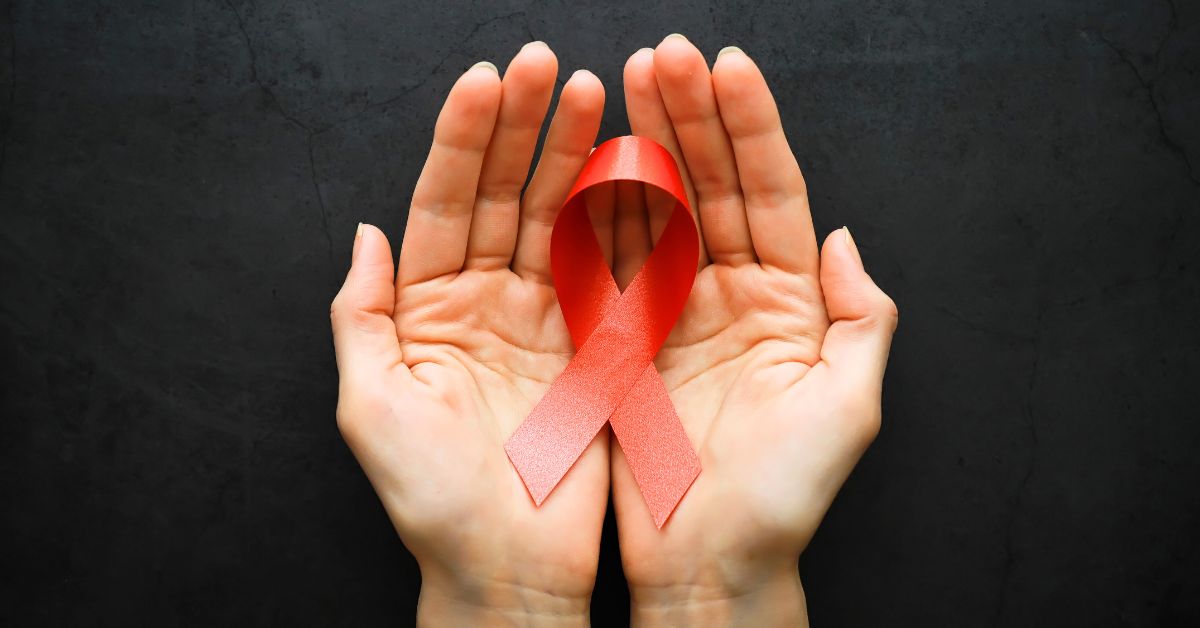World AIDS Day, observed on December 1st, kicks off this awareness month, highlighting the ongoing efforts to combat HIV/AIDS. Throughout December, various organizations and initiatives worldwide promote understanding and encourage individuals to get tested, know their status, and support HIV prevention strategies.
December is HIV/AIDS Awareness Month, and as a Registered Dietitian and educator, I feel compelled to reflect on how this epidemic has evolved over the decades, especially after noticing so many of my revised textbook editions no longer contain any information on this condition [1].
Growing up in the 1980s, I witnessed firsthand the fear, confusion, and overwhelming misinformation surrounding AIDS. I remember news reports speculating whether the virus could be transmitted through casual contact like sharing utensils or using public restrooms, leading to widespread panic. At school, rumors circulated about how the disease spread, and I recall the discomfort adults expressed in even discussing the topic openly. This environment of uncertainty and stigma left an indelible mark on how I viewed health and societal responses to crises. Fast forward to today, we live in a world where advancements in prevention, treatment, and education have made significant progress. Yet, for many underserved and marginalized communities, the HIV/AIDS epidemic remains a critical concern, often overlooked by mainstream conversations and even modern healthcare education.
The 1980s: A Time of Fear, Misinformation, and Silence
I was barely a teenager in the 1980s when news of the AIDS epidemic first started to dominate headlines. Back then, the disease was poorly understood, and the stigma was immense. AIDS was often misrepresented as a disease that affected only certain populations—primarily gay men, intravenous drug users, and people from marginalized communities. Terms like the “gay plague” and fear-driven slogans were commonplace, fostering blame and discrimination while sidelining critical efforts for research and education.
The lack of understanding was coupled with intense fear. My family, like many others, was unsure about how the disease spread. Could you get AIDS from sharing a bathroom, a handshake, or a hug? There were whispers and rumors in the classroom, at family dinners, and even in medical spaces. I distinctly remember seeing news reports about the rapid increase in death and, at such a young age, I couldn’t fathom what was happening and was genuinely freaked out by them.
The reality was sobering: without effective treatments, a diagnosis was often a death sentence. Between 1981 and 1990, tens of thousands of people lost their lives to AIDS-related complications. What we now call HIV (Human Immunodeficiency Virus) wasn’t even identified until 1984, and it would take years before real medical progress began.
Where We Are Now: Progress and Possibility
Looking back at those early days, it is nothing short of remarkable how far we have come. Today, HIV is no longer the untreatable disease it once was. Breakthroughs in medicine have transformed what was once a terminal diagnosis into a manageable chronic condition for many people. Here are some key advancements worth celebrating:
- Antiretroviral Therapy (ART): The introduction of antiretroviral therapy in the 1990s revolutionized HIV treatment. ART suppresses the virus to undetectable levels in the bloodstream, allowing people with HIV to live longer, healthier lives and drastically reducing the risk of transmission. The “Undetectable = Untransmittable” (U=U) campaign is now a global initiative, emphasizing that individuals who maintain an undetectable viral load cannot transmit HIV to their partners [2].
- PrEP and PEP: Pre-Exposure Prophylaxis (PrEP) and Post-Exposure Prophylaxis (PEP) are game-changers in HIV prevention. PrEP is a daily medication for HIV-negative individuals that significantly reduces their risk of acquiring the virus, while PEP is a short-term treatment used after potential exposure [3].
- Testing and Early Detection: Access to rapid and reliable HIV testing has improved immensely. Early diagnosis allows individuals to begin treatment sooner, improving their health outcomes and preventing further transmission [4].
- Reducing Stigma: Although stigma remains a barrier, public health campaigns and increased education have helped shift perceptions of HIV/AIDS. Organizations around the world continue to challenge outdated stereotypes and advocate for equitable healthcare access [5].
- Global Efforts: Initiatives like the UNAIDS 95-95-95 targets (95% of people with HIV know their status, 95% of diagnosed individuals receive treatment, and 95% achieve viral suppression) aim to end the epidemic worldwide by 2030. These efforts have seen notable progress in many countries [6].
While these advancements are encouraging, it is critical to recognize that HIV/AIDS is far from eradicated. According to the CDC, an estimated 1.2 million people in the United States are living with HIV today, with thousands of new diagnoses each year. Globally, the numbers are even more staggering, especially in resource-limited settings.

HIV/AIDS Today: Why It Still Matters in Healthcare Education
As an adjunct lecturer of undergraduate and graduate nutrition students at a New York City college, I’ve noticed (what I believe to be) a troubling trend: HIV/AIDS is barely mentioned in many of the textbooks we use. This is concerning because HIV remains a very real issue, particularly in underserved or marginalized communities where healthcare inequities persist, and in the neighborhoods in and around where I live and work. Not to mention that many of my students who are going on to pursue their Registered Dietitian credential may very well end up in an internship rotation—like I did in not one but two of mine a mere 8 years ago—that caters to the HIV population.
In New York City, for example, HIV rates are disproportionately high among Black and Hispanic populations, LGBTQ+ individuals, and those living in poverty. Social determinants of health, such as access to healthcare, housing stability, and nutrition security, play significant roles in both HIV prevention and treatment outcomes [7].
For nutrition professionals, understanding the relationship between HIV and nutrition is essential. Here are a few reasons why:
- HIV and Malnutrition: HIV weakens the immune system, making individuals more susceptible to infections and malnutrition. Good nutrition plays a critical role in maintaining immune function, supporting treatment adherence, and improving quality of life. For individuals with HIV, this might include ensuring adequate protein intake to support immune health, incorporating foods rich in vitamins and minerals such as leafy greens and citrus fruits, and managing gastrointestinal side effects with easy-to-digest options like bananas and rice. Tailored nutrition plans can help address specific challenges, such as managing weight loss or metabolic complications associated with antiretroviral therapy [8,9].
- Medication Side Effects: Some HIV medications can cause gastrointestinal issues, changes in appetite, and metabolic disorders. Nutrition interventions can help manage these side effects and support overall health [10].
- Food Insecurity: Many people living with HIV face food insecurity, which can hinder their ability to adhere to treatment regimens. As nutrition professionals, addressing food access and providing education on affordable, nutrient-dense options is vital [11].
- Advocacy and Education: As healthcare providers, we have a responsibility to challenge stigma, advocate for vulnerable populations, and ensure that HIV/AIDS remains part of the conversation.

Keeping the Conversation Alive
The progress we’ve made in treating and preventing HIV/AIDS is extraordinary, but the work is far from over. For healthcare professionals—including registered dietitians, physicians, nurses, and educators—it is imperative that we remain informed, compassionate, and proactive. HIV/AIDS education must not be relegated to the past; it must remain relevant in our classrooms, clinics, and communities.
If you are part of an interdisciplinary team, or are interested in continuing the conversation, please consider the following:
- Educate Future Professionals: Our students must understand the intersection of HIV, nutrition, and social determinants of health.
- Promote Equitable Care: Address disparities in access to healthcare, testing, treatment, and nutritional support.
- Destigmatize the Conversation: HIV/AIDS should no longer be shrouded in silence or fear. We must continue to foster open, honest dialogue in all settings.
- Take Action: Get tested, stay informed, and advocate for equitable healthcare. For more information, visit organizations like UNAIDS, CDC HIV, or local HIV/AIDS support groups in your area.
References
- National Institutes of Health. (2021, August 23). HIV and Nutrition and Food Safety. Hivinfo.nih.gov. https://hivinfo.nih.gov/understanding-hiv/fact-sheets/hiv-and-nutrition-and-food-safety
- National Institutes of Health. (2021, August 16). HIV Treatment: The Basics. Hivinfo.nih.gov. https://hivinfo.nih.gov/understanding-hiv/fact-sheets/hiv-treatment-basics
- Medline Plus. (2023, March 14). HIV: PrEP and PEP. Medlineplus.gov. https://medlineplus.gov/hivprepandpep.html
- Girardi, E., Sabin, C. A., & Monforte, A. d’Arminio. (2007). Late Diagnosis of HIV Infection: Epidemiological Features, Consequences and Strategies to Encourage Earlier Testing. JAIDS Journal of Acquired Immune Deficiency Syndromes, 46(Suppl 1), S3–S8. https://doi.org/10.1097/01.qai.0000286597.57066.2b
- HIV.gov. (2019, January 10). Global HIV/AIDS Organizations. HIV.gov. https://www.hiv.gov/federal-response/pepfar-global-aids/global-hiv-aids-organizations
- Frescura, L., Godfrey-Faussett, P., Feizzadeh A., A., El-Sadr, W., Syarif, O., & Ghys, P. D. (2022). Achieving the 95 95 95 targets for all: A pathway to ending AIDS. PLOS ONE, 17(8), e0272405. https://doi.org/10.1371/journal.pone.0272405
- New York State Department of Health Recognizes National Black HIV/AIDS Awareness Day. (n.d.). Www.health.ny.gov. https://www.health.ny.gov/press/releases/2024/2024-02-07_hiv.htm
- Food Safety and Nutrition. (2017, May 15). HIV.gov. https://www.hiv.gov/hiv-basics/living-healthy-with-hiv/taking-care-of-yourself/food-safety-and-nutrition
- Mannette, J., Zhang, Y., Rothfus, M., Purdy, C., Tesfatsion, W., Lynch, M., Hamilton-Hinch, B., Williams, P. L., Joy, P., & Grant, S. (2023). Exploring current nutritional programming and resources available to people living with HIV in Canada: a scoping review. Jbi Evidence Synthesis, 21(10), 2022–2081. https://doi.org/10.11124/JBIES-22-00168
- The importance of nutrition and diet in HIV and AIDS. (2021, July 13). Www.medicalnewstoday.com. https://www.medicalnewstoday.com/articles/hiv-aids-nutrition-and-diet
- Nutrition and HIV. (2019, March 18). The Well Project. https://www.thewellproject.org/hiv-information/nutrition-and-hiv



0 Comments